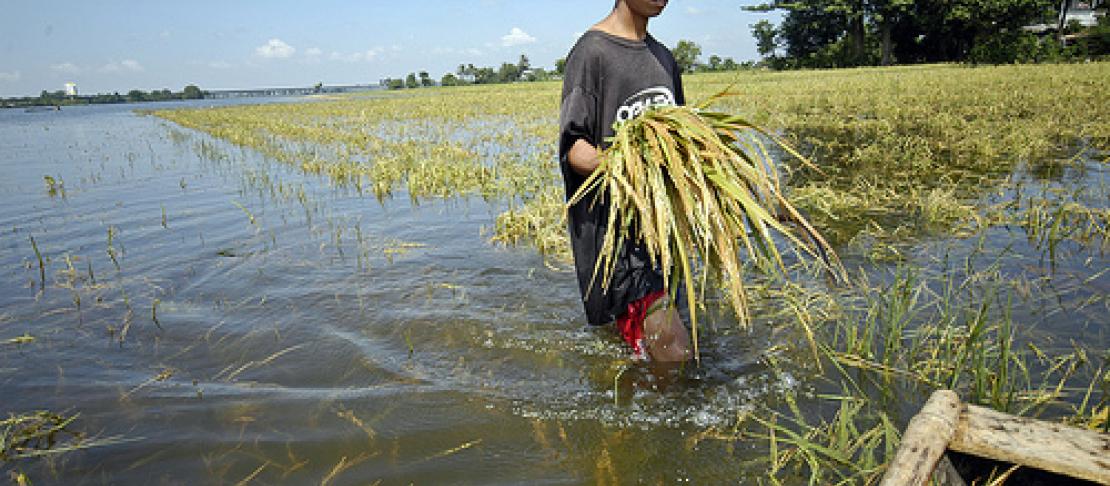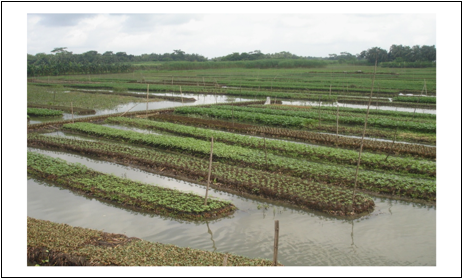Evaluating new rice varieties that better sustain floodings

By Parvin Sultana
Floods are more or less a recurring phenomenon in Bangladesh and mainly are within tolerable limits with which farming systems are well adapted. However, occasionally they become devastating. Each year in Bangladesh about 18% of the country is flooded, but during severe floods, the affected area may exceed 55% of the total area of the country. Besides flood, the changes in the timing and duration of rainfall, temperature; and duration and intensity of fog are indicators of climate change. The changed timing and duration of the flood “flash” has been observed as now it comes late in August or September and stays only for 10-15 days whereas in the past, normal flood used to occur in June-July and stayed for 1-1.5 months.
The Kamarjani-Mollarchar area in Gaibandha Sadar sub-district of north western Bangladesh is vulnerable to river flooding. In the area, Aman rice is mainly sown in July and harvested in November. However, due to flooding in August and September, farmers usually grow transplanted short stalked high yielding varieties (HYVs) or hybrid varieties of Aman rice. Nowadays, floods inundate the transplanted rice more often and if water stands for longer, then the paddy plants suffer much from stress, and when water recedes the suitable period for transplanting paddy is already over or almost over.
In such situations, one variety of local Aman rice called Ganjia, can successfully be transplanted out late after the flood water recedes. In past, farmers have lost their rice due to flooding, and therefore, now prepare extra seedbeds with two or three varieties of rice including Ganjia every year. This way, the farmers are ready for whatever flooding pattern they experience. If there are low or early floods, then the HYVs of rice can be transplanted, but if flooding is worse or if early transplanted seedlings are lost, the farmers are ready to plant the later varieties. Ganjia rice can be transplanted until mid-October and can be harvested within 2.5 months. The production of Ganjia rice is lower as compared to other HYVs, giving farmers a time period to cultivate a winter crop – preferably maize after harvesting rice.
Similarly, Rangpur Dinajpur Rural Service (RDRS, a regional NGO) has field tested three short duration varieties (IR-64 sub-1, BINA-7 and BAU dhan-1). The IR-64 variety is claimed to be short-duration (120-124 days), drought resistant and flood tolerant. The variety was tested for four years, but according to the farmers this variety is not drought resistant. The cultivation of IR-64 sub-1 variety does not need irrigation as this variety can be harvested before the drought months (November-March). Flood tolerant varieties like BR-51 and BR-52 were tested in Gangachara, Palashbari and Gaibandha Sadar area. They can withstand inundation for up to 15 days. Likewise, short-duration rice – Parija was tested. There are no other rice varieties that will grow in exactly the same time period of the year as Parija. After early harvest of Parija, farmers can grow either potato followed by mung bean, or maize followed by rice cultivation during winters.

More information
Read more about Climate Change, Agriculture and Food Security work in South Asia.
This blog post was prepared by Parvin Sultana, Flood Hazard Research Centre Bangladesh. To get more updates, follow us on Facebook, and Twitter @Cgiarclimate.


